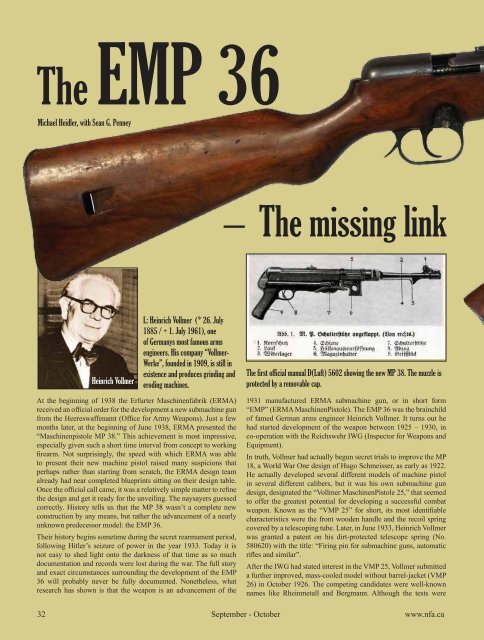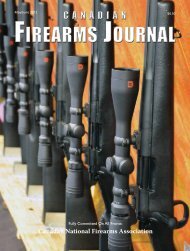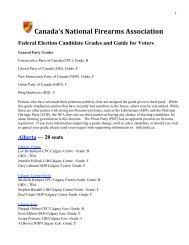download - the National Firearms Association
download - the National Firearms Association
download - the National Firearms Association
You also want an ePaper? Increase the reach of your titles
YUMPU automatically turns print PDFs into web optimized ePapers that Google loves.
EMP 36<br />
The<br />
Michael Heidler, with Sean G. Penney<br />
Heinrich Vollmer<br />
L: Heinrich Vollmer (* 26. July<br />
1885 / + 1. July 1961), one<br />
of Germanys most famous arms<br />
engineers. His company “Vollmer-<br />
Werke”, founded in 1909, is still in<br />
existence and produces grinding and<br />
eroding machines.<br />
At <strong>the</strong> beginning of 1938 <strong>the</strong> Erfurter Maschinenfabrik (ERMA)<br />
received an official order for <strong>the</strong> development a new submachine gun<br />
from <strong>the</strong> Heereswaffenamt (Office for Army Weapons). Just a few<br />
months later, at <strong>the</strong> beginning of June 1938, ERMA presented <strong>the</strong><br />
“Maschinenpistole MP 38.” This achievement is most impressive,<br />
especially given such a short time interval from concept to working<br />
firearm. Not surprisingly, <strong>the</strong> speed with which ERMA was able<br />
to present <strong>the</strong>ir new machine pistol raised many suspicions that<br />
perhaps ra<strong>the</strong>r than starting from scratch, <strong>the</strong> ERMA design team<br />
already had near completed blueprints sitting on <strong>the</strong>ir design table.<br />
Once <strong>the</strong> official call came, it was a relatively simple matter to refine<br />
<strong>the</strong> design and get it ready for <strong>the</strong> unveiling. The naysayers guessed<br />
correctly. History tells us that <strong>the</strong> MP 38 wasn’t a complete new<br />
construction by any means, but ra<strong>the</strong>r <strong>the</strong> advancement of a nearly<br />
unknown predecessor model: <strong>the</strong> EMP 36.<br />
Their history begins sometime during <strong>the</strong> secret rearmament period,<br />
following Hitler’s seizure of power in <strong>the</strong> year 1933. Today it is<br />
not easy to shed light onto <strong>the</strong> darkness of that time as so much<br />
documentation and records were lost during <strong>the</strong> war. The full story<br />
and exact circumstances surrounding <strong>the</strong> development of <strong>the</strong> EMP<br />
36 will probably never be fully documented. None<strong>the</strong>less, what<br />
research has shown is that <strong>the</strong> weapon is an advancement of <strong>the</strong><br />
– The missing link<br />
The first official manual D(Luft) 5602 showing <strong>the</strong> new MP 38. The muzzle is<br />
protected by a removable cap.<br />
1931 manufactured ERMA submachine gun, or in short form<br />
“EMP” (ERMA MaschinenPistole). The EMP 36 was <strong>the</strong> brainchild<br />
of famed German arms engineer Heinrich Vollmer. It turns out he<br />
had started development of <strong>the</strong> weapon between 1925 – 1930, in<br />
co-operation with <strong>the</strong> Reichswehr IWG (Inspector for Weapons and<br />
Equipment).<br />
In truth, Vollmer had actually begun secret trials to improve <strong>the</strong> MP<br />
18, a World War One design of Hugo Schmeisser, as early as 1922.<br />
He actually developed several different models of machine pistol<br />
in several different calibers, but it was his own submachine gun<br />
design, designated <strong>the</strong> “Vollmer MaschinenPistole 25,” that seemed<br />
to offer <strong>the</strong> greatest potential for developing a successful combat<br />
weapon. Known as <strong>the</strong> “VMP 25” for short, its most identifiable<br />
characteristics were <strong>the</strong> front wooden handle and <strong>the</strong> recoil spring<br />
covered by a telescoping tube. Later, in June 1933, Heinrich Vollmer<br />
was granted a patent on his dirt-protected telescope spring (No.<br />
580620) with <strong>the</strong> title: “Firing pin for submachine guns, automatic<br />
rifles and similar”.<br />
After <strong>the</strong> IWG had stated interest in <strong>the</strong> VMP 25, Vollmer submitted<br />
a fur<strong>the</strong>r improved, mass-cooled model without barrel-jacket (VMP<br />
26) in October 1926. The competing candidates were well-known<br />
names like Rheinmetall and Bergmann. Although <strong>the</strong> tests were<br />
32 September - October www.nfa.ca















